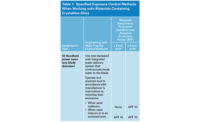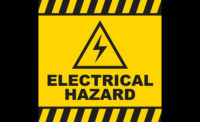Of all areas of the body, the eyes are among the most exposed to hazards on a daily basis. It takes only a single speck of flying debris to cause serious damage to an eye. It's important to remember this fact, because some workers avoid wearing eye protection, even when it's available.
OSHA requires employers to provide protective equipment when there is potential for eye injury due to machines, operations, or other jobsite conditions. But, how do you determine the potential for these injuries?
Hazard assessment
Employers are required to assess the workplace to determine if hazards are present which necessitate the use of eye, face, head, foot, hand, and personal fall protection.
If it’s determined that eye hazards are present, the employer must select protective equipment for employees and communicate the selection decisions to them.
After completing the hazard assessment, the general personal protective equipment (PPE) selection involves:
- Becoming familiar with the potential hazards and the type of protective equipment that’s available, and what it can do;
- Assessing the hazards associated with the environment;
- Selecting the protective equipment that ensures a level of protection greater than the minimum required to protect employees from the hazards; and
- Fitting the user with the protective device and giving instructions on care and use of the PPE. It’s very important that the users be made aware of all warning labels for, and limitations of, their PPE.
In addition, the employer must verify that the hazard assessment has been completed through a written certification:
- Identifying the workplace,
- Identifying the person certifying that the evaluation has been performed,
- Listing the date of the assessment, and
- Containing a statement that identifies the document as certification of hazard assessment.
Comfort and fit
Give careful consideration to comfort and fit. PPE that fits poorly will not provide adequate protection. Continued wearing of the PPE is more likely if it fits the wearer comfortably. Protective devices are generally available in a variety of sizes.
Make adjustments on an individual basis for a comfortable fit that’ll maintain the PPE in the proper position. Take particular care in fitting PPE for eye protection against dust and chemical splashes.
Training
Provide training to each employee who’s required to use eye protection. Train employees in the following:
- When PPE is necessary;
- What PPE is necessary;
- How to properly don, doff, adjust, and wear PPE;
- The limitations of the PPE; and
- The proper care, maintenance, useful life, and disposal of the PPE.
Employees must be able to demonstrate an understanding of the training, and the ability to use PPE properly, before being allowed to perform their jobs.
Types of eye protection
PPE for the eyes can include:
- Safety glasses
- Safety goggles
- Face shields
- Welding goggles
- Welding helmets
Safety glasses
Safety glasses are the most common form of eye protection. They primarily protect the wearer from the front and can be equipped with side shields for additional protection. Whenever there are flying object hazards, side protection is required.
Safety glasses must have metal or plastic safety frames and impact-resistant lenses. They are used for jobs with moderate-impact particle hazards.
Do not wear safety glasses over regular glasses, unless the safety glasses are designed for that purpose. If issuing prescription safety glasses, a qualified optical technician will need to fit them.
Safety goggles
Safety goggles surround and cover the eyes and protect them from impact, dust, and splash hazards. Goggles are available with removable or non-removable lenses. Some goggles have ventilation openings for air to circulate through the cup to prevent fogging.
All goggles are meant to be tight fitting. Make sure employees wear goggles that fit properly and protect from all potential hazards in your workplace.
If employees wear prescription glasses, make sure the goggles fit snugly against their face when over the glasses and that the worker’s vision is clear. Not all goggles will fit over eyeglasses.
Face shields
These transparent sheets of plastic extend from the eyebrows to below the chin and across the entire width of the employee’s head. Some are polarized for glare protection. Face shields protect against nuisance dusts and potential splashes or sprays of hazardous liquids but will not provide adequate protection against impact hazards.
Face shields must always be worn over primary eye protection (such as safety glasses or goggles).
Welding goggles
Welding goggles protect the eyes from intense concentrations of light and radiation produced by lasers and welding operations. Welding goggles may be worn under welding helmets. However, goggles may not fit properly underneath a welding helmet. If possible, use a welding helmet with a proper protective lens to avoid the need for goggles or other eye protection.
Welding goggles are rated with different shade numbers to filter and protect against radiant energy. The minimum protective shade number required varies due to the type of welding, electrode size, and arc current. See 29 CFR 1910.133(a)(5) and 1910.252(b)(2)(ii)(H) for specific shade number requirements for different welding operations. As a best practice, it’s good to start with a shade that is too dark to see the weld zone. Then, go a shade lighter without going below the required minimum.
Welding helmets
A welding helmet surrounds the face, neck, and ears. It protects against burns from radiation and intense light, as well as from the sparks, splatters, and chips produced during welding operations. Eye protection needs to be worn under a welding helmet if the hood doesn’t have a proper protective front lens.
Like welding goggles, welding lens plates are rated with different shade numbers to filter and protect against radiant energy.
Workers can also use hand shields to protect against hot work hazards. A welding helper or attendant holds the hand shield for the welder and is for short-term welding applications.
Eye protection inspection and care
Employees must inspect eye protection daily. During the inspection, they should look for dirty, pitted, cracked, scratched, or broken lenses and frames. Proper care means keeping the lenses and frames clean and in good condition. Follow the manufacturer’s recommendations for cleaning and maintenance.
Instruct employees to store their eye protection in an area where it’s protected from dirt, damage, and environmental conditions.
Takeaways
Employees’ eyes are vulnerable to hazards from flying particles, molten metal, liquid chemicals, acids or caustic liquids, chemical gases or vapors, and injurious light radiation.
After performing a hazard assessment, the employer is required to provide the proper eye protection if it’s needed to protect employees.



